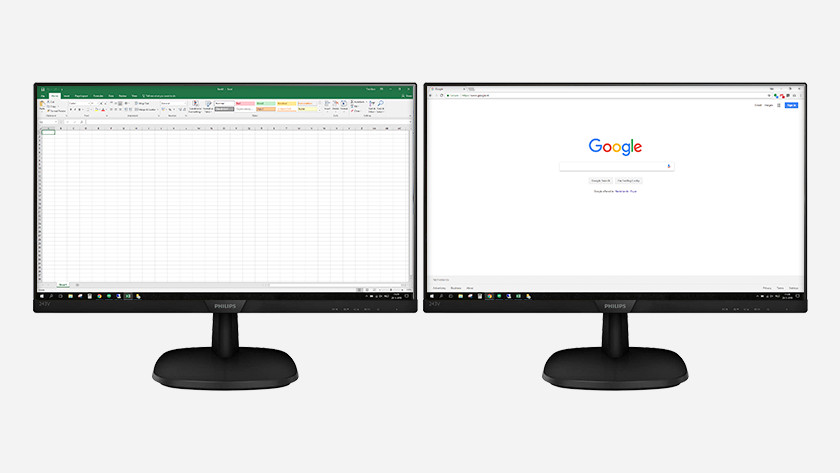Ergonomics for Multiple Monitors
Today we’re taking a look at a recently submitted question regarding properly adjusting a workstation with two large monitors:
I have a question and need some advice. I have a customer who has two large 30 inch screens sitting directly in front of her. She says she is having pain using them, but needs both of them to work on reports.
Do you have any advice on how best to position them so she is not cranking her neck back and forth. The only thing I have suggested is to set them back a bit (instead of an arms length away). Thoughts?

Read what Back School Director, Ron Porter, had to say below.
There are a few ways to decrease the movement of your client’s head when looking at the two large 30 inch screens.
As you have mentioned, you need to move her head further away from the two screens. An arm’s length which is about 20”-24” is not enough distance for two 30” screens. Increasing the distance between the eyes and screens can be accomplished by moving the screens further back on her work surface or moving her further away from the front edge of the work surface.Placing the screens on monitor arms would make the repositioning easy and could give her more desk space. Another way to increase the distance between the eyes and screens is to install a keyboard tray that will move her further away from her work station when doing data entry. We also have given dual monitor users one large screen so they can split the screen for two images (on the one screen) instead of using two screens.
When increasing the distance from head to screen(s) you may also need to increase the size of the font. This is usually identified if you ask the client l to read out loud information from each screen and they lean in toward the screen to see the information.
Hope this helps!
Have you had any experience performing assessments on clients with multiple monitors? Let us know in the comments below.



I actually get this quite often. I typically have them angle the screens in slightly to decreased the “real estate” that they have to gaze at. I also ensure that the point where the two screens touch is in line with their nose. Often times, one screen is off of center and this is actually what is creating the problem. When in doubt, have your client increase water intake. This will increase nature breaks away from the screen! Movement is key!
With 2x 30″ wide monitors, consider an adjustable duo stack monitor mount (one on top of the other). This narrows the required field of vision as screens are typically wider than tall. You may still need to increase the client distance from their monitor(s), increase font, and the top monitor should be tilted toward the client to stay equal distance from the eyes. This strategy can decrease the horizontal ocular scanning distance and minimize neck compensation due to ocular muscle fatigue.
Of note, this would do well combined with education, stretch/rest breaks and everything else we do to address the whole situation/client work load. But an added option to think about.
When significantly increasing the distance between the user’s eyes and the monitors, it may also be helpful to adjust the eye-wear (add or adjust computer glasses) in addition to increasing font size, as this may not be possible with all programs or may result in the loss of some content. Another option with two wide screens may be to decrease the width of the window of the content and move it towards the center of the viewing area on each screen. I would be cautious with stacking monitors as I have found clients tolerate repetitive cervical rotation more easily than flexion/extension.
I sometimes have them flip one screen into vertical position and then center both. Whatever content is in the vertical monitor is moved to eye level. I find most employees rarely need the entire width 2×30″ monitors provide. This also saves space.